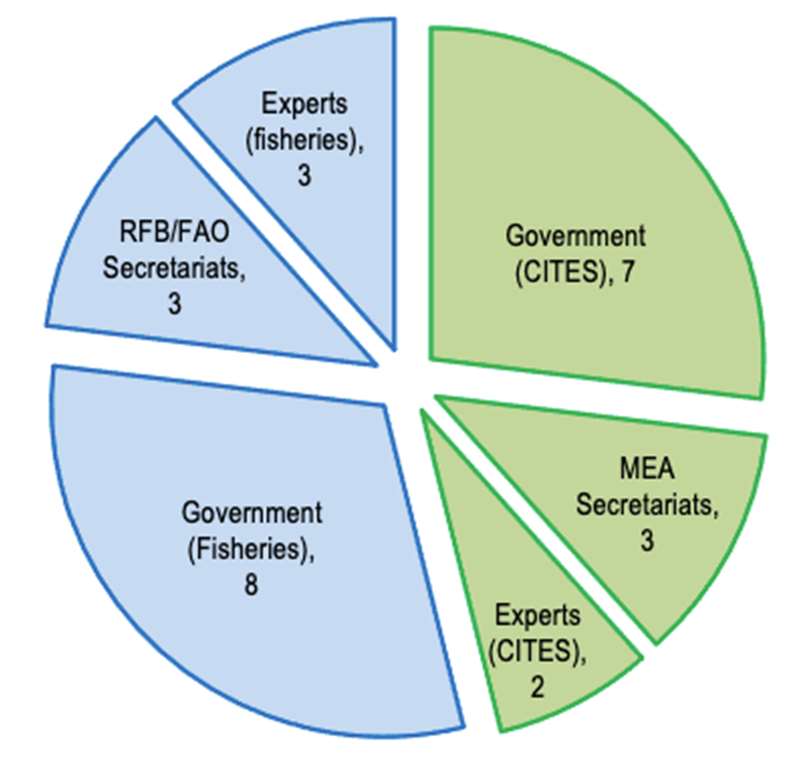Sharks and rays are iconic creatures – yet many species remain under threat due to unsustainable fishing practices. The Convention on International Trade in Endangered Species of Wild Fauna and Flora (CITES) introduced key protections - for example for hammerheads in 2013 and silky sharks in 2017 (Figure 1) – but progressed has remained slow.
Experts in the field of shark ecology and the fisheries sector have identified that the main cause of conservation limitation is a lack of coordination between the environment and fisheries sectors, whether that be a simple mismatch in technical language used in reporting or the more complex requirement of monitored, formal communication.
In response to this, the German government launched a NatureBureau-led project to improve cooperation between CITES and Regional Fisheries Management Organisations (RFMOs) and Bodies (RFBs) through expert surveys and strategy development
This project’s work feeds directly into the IUCN World Conservation Congress 2025 in Abu Dhabi. Our expert survey and workshop series are not just an isolated study; they’re a stepping stone toward policy innovations that can make a measurable, real-world difference for the future of sharks, rays, and their habitats.


Figure 1 - Hammerhead shark (left) and silky shark (right). Both species are listed in CITES Appendix II.
The project delivered three main outputs: a status report on CITES-listed sharks (pre-COP-19, 2023) covering conservation, fisheries, trade and management, an international expert survey inquiring about the gaps leading to deficits in shark conservation, and a three-part online workshop series bringing together relevant stakeholders in the field. All project reports and materials are available via the BMUKN website.
Following the completion of the initial status report of CITES shark species, and to identify where the gaps lie in their protection, we turned to the expertise of stakeholders directly involved in policy implementation.
Gathering insights from global experts
The survey was rare in its scope, involving leading experts in shark ecology, fisheries and international governance.

Figure 2 - Number of interviews by sector: Government agencies of Contracting Parties to CITES and RFMOs, Secretariats of multilateral fisheries (RFBs & FAO) and environmental agreements (MEA), and independent experts.
Interviews revealed strong consensus on the need for closer CITES-RFMO collaboration. While participants acknowledged the complementarity of respective mandates, they noted limited mutual understanding, particularly from the fisheries sector regarding CITES processes such as Legal Acquisition Findings and Introduction from the Sea.
Identified barriers included: lack of formal structures, limited political will, weak implementation capacity, and inadequate data reporting. To address these, interviewees proposed several solutions. Appointing focal points was seen as crucial to improving communication and joint guidance. Other widely supported measures included regional collaboration on Non-Detriment Findings (NDFs), capacity-building for shared mandates, and formalising inter-agency coordination.
Turning solutions into action: workshop series highlights
A workshop series was designed to address the gaps identified by the expert surveys by fostering dialogue, developing shared understanding, and turning ideas into action.
The workshop series involved stakeholders from a range of sectors, reflecting the collaborative spirit that is a hallmark of the IUCN World Conservation Congress. The Congress offers a unique platform for policy makers, practitioners, community groups and stakeholders to come together, align their strategies, and collectively accelerate action for conserving these vulnerable species.
Workshops introduced stakeholders, built shared understanding and produced key measures to strengthen collaboration.
The transition to nature-positive societies and economies is among the most urgent challenges facing humanity. As biodiversity declines, striking a balance between sustaining human populations and preserving natural resources is critical, particularly at the top of the food chain where long-lived, slow-reproducing species like sharks are especially vulnerable. This project supports that shift through coordinated shark and ray management.
Harnessing the power of the IUCN Congress for collaborative action
Projects like this help align trade and fisheries governance to support shark recovery and marine health. Expert interviews revealed candid cross-sector insights, underscoring the initiative’s value. The IUCN World Conservation Congress 2025 is a crucial opportunity to bring these policy innovations forward and collectively accelerate progress toward conserving sharks, rays, and their habitats.
This project directly contributes to delivering the policy priorities set by IUCN Members in several key motions at the IUCN Congress 2025 in Abu Dhabi, especially motions 033 and 118. These motions call for port state measures regarding illegal, unreported and unregulated fishing and the conservation of the critically endangered scalloped hammerhead shark (and lookalikes), covering the overlapping fisheries and environmental aspects of shark conservation highlighted by this work. It exemplifies the kind of multi-lateral, policy-oriented action that IUCN promotes for nature conservation and sustainability.
Authors:
Athena Allen(1), Timm Reinhardt(2), Babak Miller(3), Astrid Wiik(4), Sarah Fowler(5)
- 1 Marine Ecologist, NatureBureau Ltd. – Member of IUCN Commission on Ecosystem Management
- 2 Department of Wildlife Conservation, Bundesamt für Naturschutz, Germany
- 3 Policy Advisor, Federal Ministry for Environment, Nature Conservation and Nuclear Safety, Germany
- 4 Policy Advisor, Federal Ministry for Environment, Nature Conservation and Nuclear Safety, Germany
- 5 Independent Consultant - IUCN SSC Shark Specialist Group (founding member)